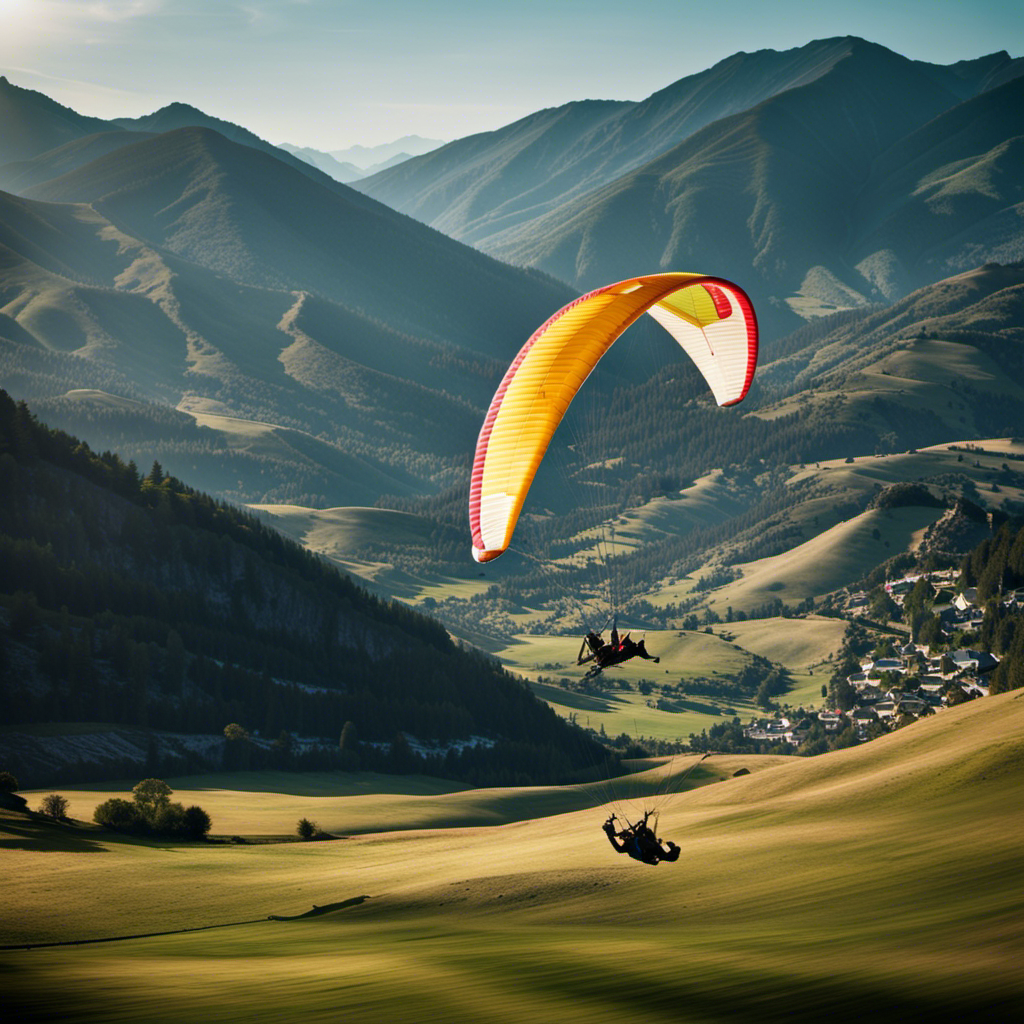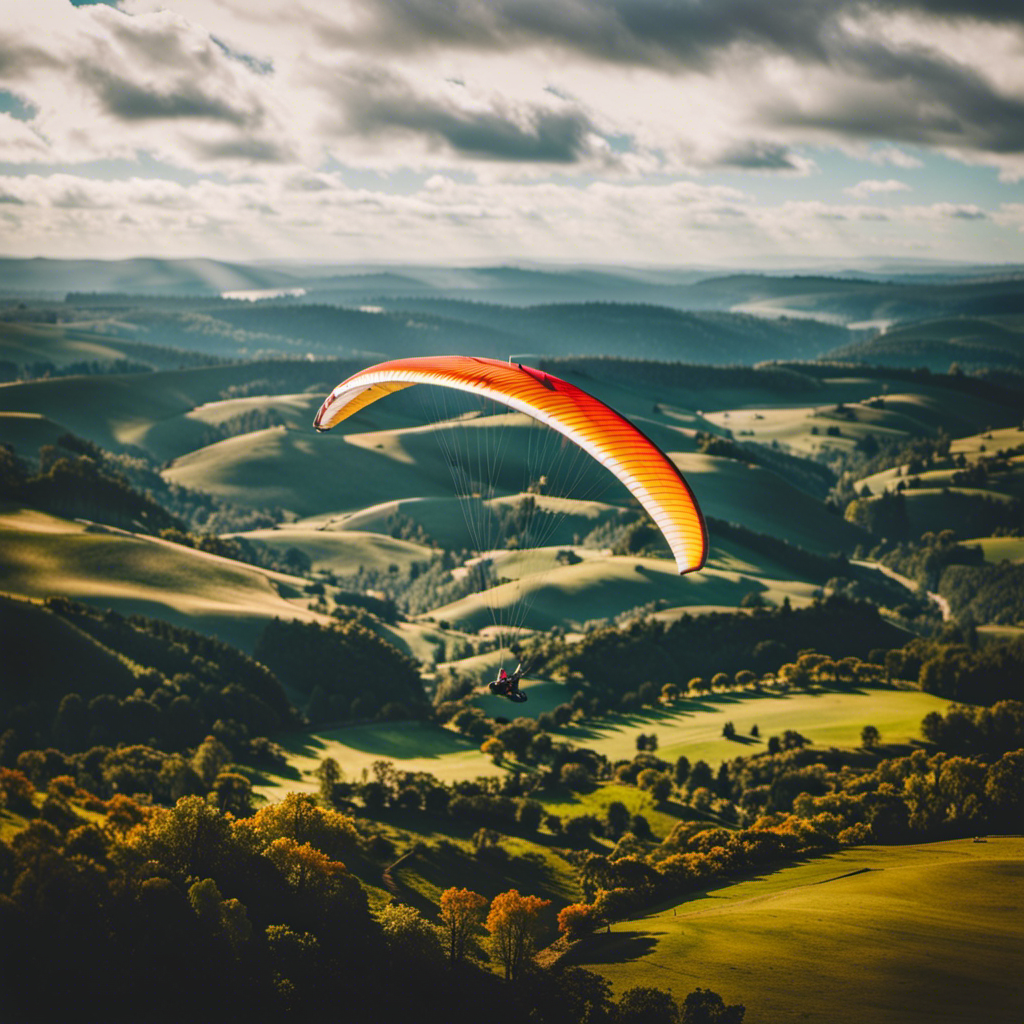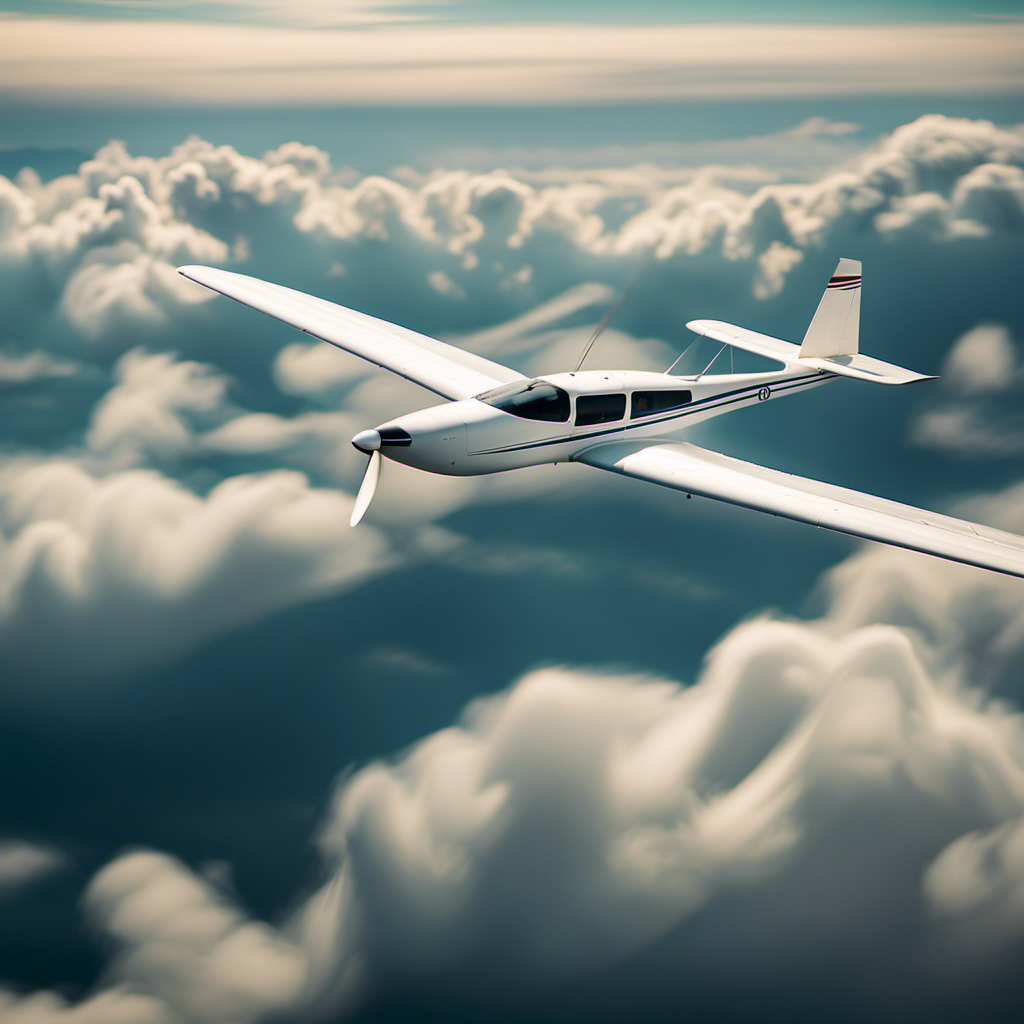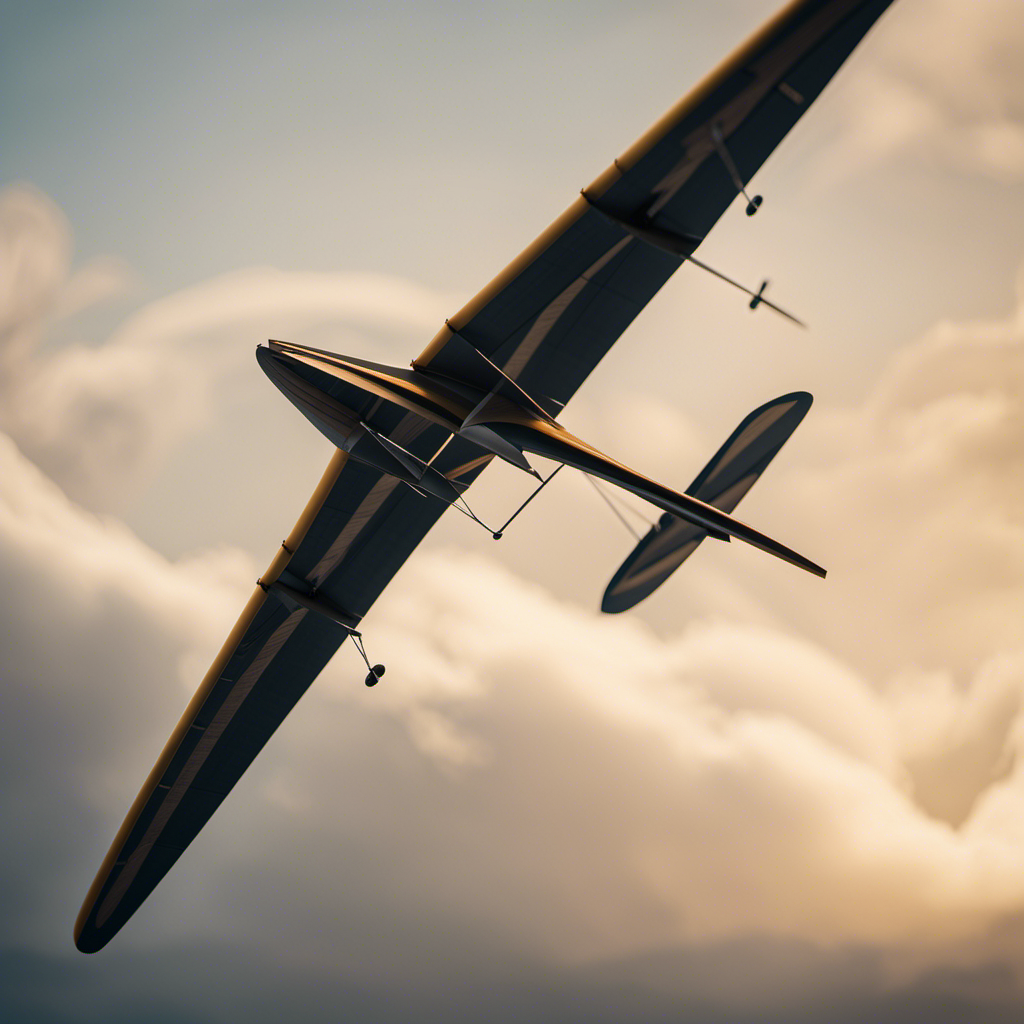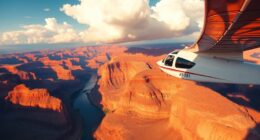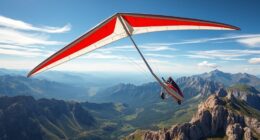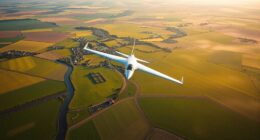As a pilot who flies gliders, I am constantly amazed by the incredible distances these graceful planes can travel. It may seem contradictory that an aircraft without an engine can glide across hundreds of miles, but it is true.
In this article, we will delve into the fascinating world of gliding and explore the factors that determine a glider’s range. From the longest glider flights in history to techniques for maximizing range, we will uncover the secrets behind this exhilarating sport.
So buckle up and get ready to soar through the skies with me as we unravel the mysteries of how much distance a glider can truly fly.
Key Takeaways
- Advancements in materials and design have allowed gliders to achieve longer and more efficient flights.
- Gliders have the potential to become a sustainable transportation option due to their eco-friendly nature and potential use of alternative power sources.
- Safety considerations, such as meticulous pre-flight inspections and adherence to communication protocols, are important in gliding clubs to ensure a welcoming and safe environment for enthusiasts.
- Gliding offers a thrilling and liberating experience, with an emphasis on understanding glider aerodynamics and proper maintenance for optimal flight conditions.
The Basics of Gliding
If you’re new to gliding, it’s important to understand the basics of how a glider works. Glider aerodynamics play a crucial role in its flight capabilities. The shape and design of the glider’s wings allow it to generate lift as it moves through the air. This lift counteracts the force of gravity, allowing the glider to stay airborne.
Additionally, the glider’s flight controls play a vital role in maneuvering the aircraft. The primary flight controls include the ailerons, elevator, and rudder. The ailerons control the roll of the glider, the elevator controls its pitch, and the rudder controls its yaw. By manipulating these controls, a pilot can change the glider’s direction and attitude in flight.
Understanding these fundamental aspects of gliding is essential to comprehend the factors that determine a glider’s range.
Factors that Determine a Glider’s Range
To determine how far you can go in a glider, factors such as wind speed, air density, and the glider’s weight play a crucial role in determining your range. Glider performance is heavily influenced by aerodynamics and lift. The shape of the glider’s wings, known as the airfoil, is designed to generate lift by creating a pressure difference between the upper and lower surfaces. This lift allows the glider to stay in the air and counteract the force of gravity. The glider’s weight affects its ability to maintain altitude and stay aloft. Wind speed and air density also impact glider performance, as they influence the amount of lift generated by the wings. Understanding these factors is essential for maximizing the range and duration of your glider flights.
In the subsequent section, we will explore the longest glider flights in history, showcasing the incredible achievements of glider pilots who have pushed the boundaries of what is possible in unpowered flight.
Longest Glider Flights in History
I’ve always been fascinated by the records set in gliding for both distance and duration. It’s truly remarkable to see how far and how long gliders can stay in the air without any propulsion.
Some notable achievements include the flight of Steve Fossett, who flew over 2,000 kilometers in a glider. This showcases the incredible capabilities of gliders and the skill of their pilots.
Another impressive record is the continuous flight of Klaus Ohlmann, who stayed aloft for over 56 hours. This demonstrates the endurance and determination of glider pilots.
These records highlight the amazing feats that can be accomplished in gliding and inspire others to push the boundaries of what is possible in this sport.
Records for distance and duration
You can find records for distance and duration achieved by gliders. The world record for the longest distance flown by a glider currently stands at an impressive 3,008.5 kilometers (1,868.6 miles). Klaus Ohlmann and his co-pilot, Karl Rabeder, accomplished this remarkable feat in 2003 by flying their glider from Germany to Spain. It truly showcased the incredible capabilities of glider aircraft.
In terms of duration, the record is held by Jim Payne and Morgan Sandercock, who flew for a staggering 76 hours and 45 minutes in 2019. This achievement highlights the extraordinary endurance and efficiency of gliders.
Moving on to notable achievements in gliding…
Notable achievements in gliding
One standout achievement in gliding is the record-breaking duration of 76 hours and 45 minutes, set by Jim Payne and Morgan Sandercock in 2019. This remarkable feat not only showcases the capabilities of gliders but also serves as a testament to the skill and determination of these pilots.
Such notable achievements in gliding inspire countless others to push the boundaries of what is possible in this exhilarating sport. From breaking distance records to surpassing previous altitude limits, gliding enthusiasts continue to amaze with their accomplishments.
These inspiring stories of human ingenuity and perseverance in the face of challenges motivate aspiring glider pilots to strive for greatness.
Now, let’s delve into the techniques for maximizing glider range, where pilots employ various strategies to extend their flight time without relying on engine power.
Techniques for Maximizing Glider Range
To maximize your glider’s range, try using techniques such as finding thermals and avoiding areas of sinking air. These methods are essential for maximizing lift and optimizing glide ratio.
Here are some tips to help you achieve the best possible range:
-
Find thermals: Look for areas where warm air is rising. Thermals can provide a significant boost to your glider’s altitude and extend your flight.
-
Avoid sinking air: Stay away from regions where cool air is descending. Sinking air will decrease your glider’s lift and shorten your flight.
-
Use ridge lift: Fly along the edges of hills or mountains to take advantage of the upward airflow caused by the wind hitting the terrain.
-
Practice energy management: Learn to efficiently convert altitude into speed and vice versa to maintain momentum and extend your glide.
Gliding Competitions and Challenges
Participating in gliding competitions and challenges provides an exciting opportunity to showcase your skills and compete against other experienced pilots. These events not only test your abilities, but also allow you to learn from and be inspired by the best in the field.
In these competitions, glider performance is crucial. Pilots aim to maximize their glide ratio, which is a measure of how far the glider can travel horizontally for each unit of altitude lost. It requires careful management of speed, angle of attack, and energy conservation techniques.
Additionally, glider navigation plays a vital role in these competitions. Pilots must analyze weather conditions, wind patterns, and thermals to plan their routes effectively, ensuring they cover the maximum distance possible.
Transitioning to the subsequent section about glider design and technology, it is essential to understand how these factors impact the overall performance and capabilities of a glider.
Glider Design and Technology
When designing a glider, you should consider the latest advancements in technology for improved performance. One key aspect to focus on is the choice of glider materials. Lightweight and strong materials such as carbon fiber composites and high-strength alloys are often used to construct the glider’s frame and wings. These materials help to reduce the overall weight of the glider, allowing for better maneuverability and increased glide ratio.
Additionally, advancements in aerodynamics and wing design have led to improved glider performance. Sleek, streamlined wings with optimized airfoil shapes reduce drag and increase lift, resulting in longer and more efficient glides. By incorporating these advancements in materials and design, glider performance can be significantly enhanced.
Now let’s explore the vibrant world of gliding clubs and communities, where enthusiasts come together to share their passion for soaring through the skies.
Gliding Clubs and Communities
Gliding clubs and communities offer a welcoming environment for enthusiasts to connect and share their love for soaring through the skies. These clubs serve as a hub for glider training and maintenance, providing a platform for individuals to learn and hone their skills in a controlled and supportive setting.
Glider training programs typically include comprehensive instruction on flight techniques, safety procedures, and emergency protocols. In addition to training, gliding clubs also play a crucial role in ensuring proper glider maintenance. Regular inspections, repairs, and upkeep are essential to maintain the airworthiness of the gliders.
By fostering a community of like-minded individuals, gliding clubs create an atmosphere of camaraderie and knowledge sharing, where members can learn from each other’s experiences and collectively contribute to the growth of the sport.
Transitioning now to safety considerations in gliding, it is imperative to carefully assess and mitigate potential risks to ensure a safe and enjoyable flying experience.
Safety Considerations in Gliding
To stay safe while soaring through the skies, it’s important to familiarize yourself with proper safety protocols and procedures in gliding. As a glider pilot, I prioritize safety precautions and emergency procedures to ensure a smooth and secure flight.
Here are some key considerations:
-
Pre-flight inspection: Before taking off, I meticulously inspect the glider for any signs of damage or malfunction.
-
Weather monitoring: I continuously monitor weather conditions to avoid flying in unfavorable situations such as strong winds or thunderstorms.
-
Communication protocols: I follow established communication protocols with ground control and other pilots to maintain situational awareness.
-
Emergency landing procedures: In the event of an emergency, I am trained to execute emergency landing procedures, including selecting suitable landing spots and performing emergency maneuvers.
-
Safety equipment: I always ensure that I have the necessary safety equipment, such as a parachute and emergency locator transmitter, readily available.
Gliding as a Sport and Recreation
By adhering to safety precautions and emergency procedures, I can confidently enjoy gliding as a sport and recreation, knowing that I am well-prepared for any unforeseen circumstances.
To ensure a safe and enjoyable gliding experience, proper glider maintenance is crucial. Regular inspections and repairs are necessary to ensure that the glider is in optimal condition. This includes checking the control surfaces, airframe, and landing gear for any signs of wear or damage.
Additionally, understanding glider aerodynamics is essential for a smooth and efficient flight. Knowledge of lift, drag, and weight distribution allows me to make precise adjustments to maximize performance.
By maintaining my glider and understanding its aerodynamics, I can fully embrace the thrill and freedom of gliding.
Looking ahead, the future of gliding holds exciting possibilities for advancements in technology and safety measures.
The Future of Gliding
As a glider pilot, I’m excited to discuss the future of gliding and its potential for sustainable and eco-friendly advancements.
With the constant advancements in technology, gliders have the potential to become even more efficient and environmentally friendly. This would reduce their carbon footprint and make them a viable option for transportation and exploration.
By showcasing the benefits and thrill of gliding, we can inspire the next generation of pilots to take up this incredible sport. They can continue pushing the boundaries of what is possible in the world of gliding.
The future of gliding is bright, and I can’t wait to see how it evolves in the coming years.
Sustainable and eco-friendly advancements in gliding
One of the most promising advancements in gliding is the development of sustainable and eco-friendly materials for glider construction. In recent years, there has been a growing emphasis on reducing the carbon footprint of gliders and finding alternative sources of power.
Solar powered gliders have emerged as a viable solution, harnessing the energy from the sun to sustain flight. These gliders are equipped with photovoltaic cells that convert sunlight into electricity, powering the aircraft’s systems and propulsion. This not only reduces the reliance on fossil fuels but also minimizes the environmental impact associated with traditional gliders.
Potential for gliders in transportation and exploration
Solar-powered gliders offer a sustainable and efficient option for transportation and exploration. They utilize renewable energy to power their systems and propulsion. With advancements in technology, the potential applications for solar-powered gliders are expanding rapidly.
These gliders can be used for long-distance aerial surveys, monitoring environmental conditions, and even delivering supplies to remote areas. The ability to harness solar energy allows these gliders to have extended flight times, making them ideal for missions that require long endurance.
Additionally, the lightweight and aerodynamic design of these gliders allows for increased maneuverability and efficiency. As solar technology continues to advance, we can expect even greater capabilities from these gliders, opening up new possibilities for transportation and exploration.
This exciting field of research is inspiring the next generation of glider pilots to explore the potential of renewable energy in aviation.
Inspiring the next generation of glider pilots
If you’re interested in becoming a glider pilot, the advancements in solar technology and the potential for sustainable flight are sure to inspire you.
Glider pilot training has become more accessible and affordable, thanks to the availability of glider pilot scholarships. These scholarships provide aspiring pilots with the opportunity to learn the necessary skills and knowledge required for glider flying.
Glider pilot training involves learning about aerodynamics, meteorology, navigation, and flight planning. It also includes hands-on experience in flying gliders and understanding their unique characteristics.
With the support of glider pilot scholarships, students can focus on their training without the financial burden. This allows them to fully immerse themselves in the world of gliding and pursue their passion for sustainable flight.
Frequently Asked Questions
Are there any age restrictions for gliding?
There are age restrictions for gliding to ensure safety. The minimum age varies by country, but typically ranges from 14 to 16 years old. Safety measures include proper training, supervision, and adherence to regulations.
What is the typical duration of a glider flight?
Typically, a glider flight lasts for several hours, depending on the typical glide ratio and various factors like wind conditions, altitude, and pilot skill. The duration can be extended by utilizing thermals and updrafts.
What are the different types of gliders available?
There are various types of gliders available, each designed differently and made from different materials. These factors affect their performance and overall flight characteristics.
How does weather affect gliding operations?
Weather conditions have a significant impact on gliding operations, particularly on flight duration. Factors like wind speed, direction, and atmospheric stability can determine how long a glider can stay aloft and cover distance.
Can gliders fly at night?
Yes, gliders can fly at night with proper flying conditions. Safety measures for gliding at night include the use of navigation lights, night vision equipment, and careful consideration of weather conditions and visibility.
Conclusion
In conclusion, gliding is an exhilarating sport that allows pilots to soar through the skies with grace and precision.
The distance a glider can fly depends on various factors, such as weather conditions, pilot skills, and the design of the glider itself. However, with the right techniques and strategies, gliders have been known to achieve impressive distances.
The future of gliding looks bright, with advancements in technology and a growing community of enthusiasts.
So, strap in and get ready for an unforgettable adventure in the world of gliding.


